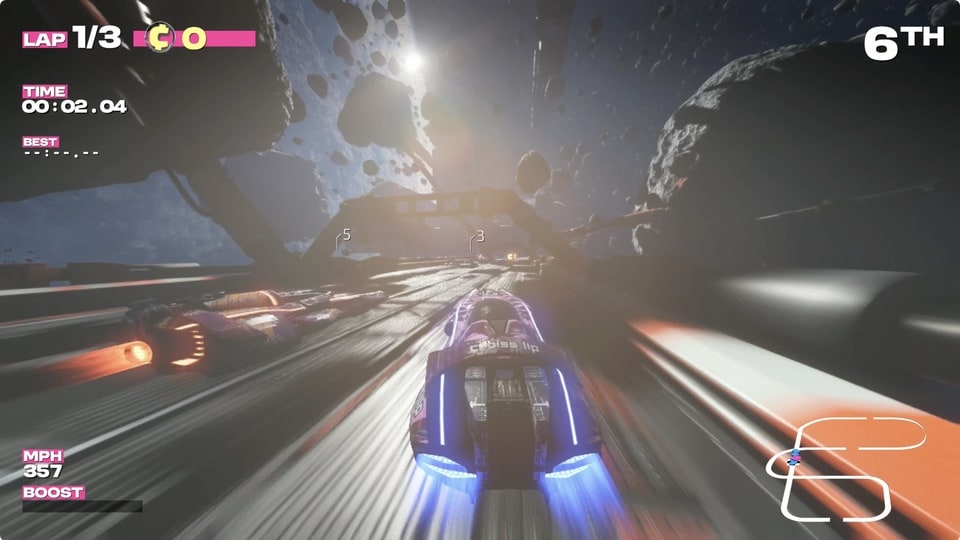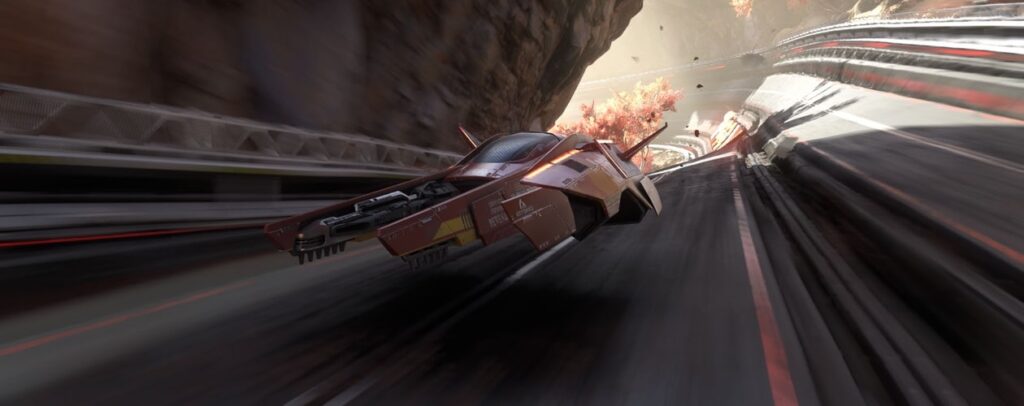Fast Fusion was my first Switch 2 game. While I had Mario Kart World waiting in the wings, it was this indie racer, available at launch for a bargain price, that was my first choice for the brand new Nintendo system. You might be wondering if I’ve lost all my marbles, but if you’re a Nintendo fan, you’ll know that this is a racing series that’s consistently delivered an experience far beyond its indie trappings. We’re not getting a new F-Zero or Wipeout, but with Fast Fusion, you likely won’t care.
Anti-grav racing is hardly new – Wipeout first appeared on the PlayStation in 1995, and F-Zero on the SNES in 1990 – but time, or licenses, seem to have dwindled in recent years for a futuristic sub-genre that used to sit on the cutting edge of tech. The Fast series began life on the Wii with Fast Racing League, appearing on the Wii U with Fast Racing Neo and then an enhanced version on the original Switch with Fast RMX. Each time, developers Shin’en Multimedia found a way to make the hardware sing, producing games that looked like AAA racers on indie budgets, and keeping a genre alive to boot.
Fast Fusion looks like a true current gen racing title, fit for your PS5 or Xbox Series X. The different tracks in particular look stunning, with the sweeping views as you load into a race showcasing the detail and depth of each intergalactic locale. While each track is tied together by industrial sections of gleaming metal, the different landscapes shift between the traditional vision of the future with its towering structures of metal and glass and more naturalistic luscious forests, each track also bringing different hazards to bear on the racers as well. The incremental details are just amazing, from Sand Whales leaping out of the desert, to the Ewok-esque tree hazards in the forest
Fast Fusion, as with its predecessors, is a true racing game. There is combat, but it’s not in the vein of Wipeout or Mario Kart where you’re given weaponry to help move up the leaderboard. Fast Fusion is about going, well… fast, and while your vessel is pretty nippy to begin with, even on the introductory Subsonic circuits, you need to utilise boosting to succeed.

There’s two types of boost. Firstly, you collect charges as you race, which alongside serving as currency, also give you a shot of nitro for each one you collect. You don’t hold this boost down, instead firing singular shots of it off, allowing you to be more directed with it. These boosts also allow you to attack your competitors, and hitting a player while you’re boosting will see them spin out, slowing them down and putting you ahead.
You gain the other type of boost via the coloured speed pads found on the floor of each circuit. Coming in blue or red, you have to select your vehicle’s frequency to match that – shown in the exhaust fumes coming from your ship – and if they match you’ll speed up significantly.
Get it wrong, and the pad will actually slow you down, electricity arcing from the ship to the pad as it struggles for anti-grav traction. It’s such a simple mechanic, but an incredibly clever one. Many circuits will also stagger differently coloured pads back-to-back, and it throws in rhythm action test of your reactions beyond the actual racing.
You start off with access to three ships, with fourteen standard craft available in total. What’s interesting here, and what gives the game the ‘Fusion’ in the name, is that you can mash two of them together, creating a new craft that draws in elements from each of the original ones. After completing the first cup, I merged the primary ship with one I bought, upping both the top speed and the boost capacity, while adding to the weight, giving it a whole new look along the way.
Despite weighing more, this new ship was a clear improvement, and the whole idea just feels great, like you’re taking part in futuristic racing R&D. It also gives you a ton of options to explore in terms of visuals and stats, giving you an added reason to unlock all of the ships as you clear the different Leagues.
The vehicles here clearly owe a debt to Wipeout’s art direction, but it’s pretty hard to truly innovate in the space when the Psygnosis team perfected the concept on the first attempt, and then upped the fidelity each time It’s simply a stunning looking game though. Fast Fusion looks like a current-gen title, and it’s got to be amongst the best-looking indie racers of all time.
Quite how the team continue to pull off this feat, I’ll never know, but they do, and here it’s delivered in 60FPS with HDR. Interestingly, there’s a host of graphics settings to choose from too, and you can go all the way up to 4K at 30fps if you want Ultra Quality, but there’s presets that target 60fps with varying shadowing and details for 4K, 1440p and 1080p. Frankly, it looks amazing in the 1080p Performance mode, and I was hard pressed to see too many differences in the more graphically intensive settings above it. As long as it’s 60fps, they all feel great.
Those spectacular visuals are combined with genre-required hard-hitting electro and dance, but rather than just relying on the familiar, there’s a suite of interesting instrumentation from around the world, as well as more dramatic, symphonic pieces that wouldn’t sound out of place in a sci-fi movie. The different tracks fit perfectly with the different tracks and areas they represent, and they’re undeniably part of the game’s character and appeal.
Fast Fusion offers plenty of longevity, with the Championship racing your initial gateway into the game. Each League contains multiple races, unlocked via the same currency you use to buy and fuse your ships – it’s worth remembering this at the start, as I spent all my money on ships before realising I needed money to advance to the next League – and there’s a svelte selection of twelve tracks in total to race on. More tracks would be lovely, but it’s worth remembering the £13.50 price point.
There’s then Super Hero Mode, which tasks you with completing a race in first place, without crashing, while jumping decreases boost energy, and that boost energy is also your shield energy. When it calls it Super Hero Mode, it flipping means it, and this is a cruel and punishing reworking of the game’s rules to push you to the limit. It gives you some lovely prize money for succeeding though, so you can buy a new ship after you’ve got over the whole thing.
Time Trial does exactly what you’d expect it to, though it gives you the Shin’en team’s best lap time to beat for each track, once more giving you some cash for achieving it, as well as giving you the bragging rights for beating the people that made the game.
Multiplayer is perhaps the biggest sign that this is a budget release, as there’s a limited online racing component. You can race in splitscreen with up to three friends, or there’s GameShare functionality which lets you beam the game to another Nintendo Switch 2, either locally or via the Switch 2’s new GameChat function. With GameShare everyone gets to race on their own Switch 2, with the host Switch 2 rendering and streaming a game view of the race for each individual player, but you’re playing with only one copy of the game. It’s great that you can experience racing against your friends, but I’ll be hoping that Fast Fusion sells well enough that Shin’en decide to add a true online component in the future.
